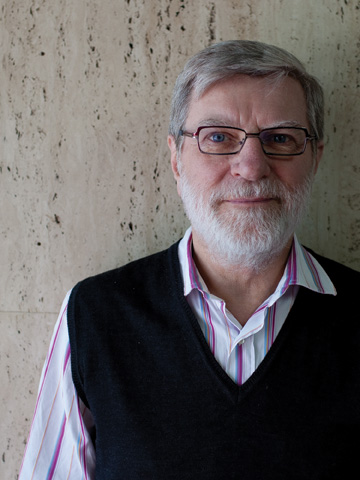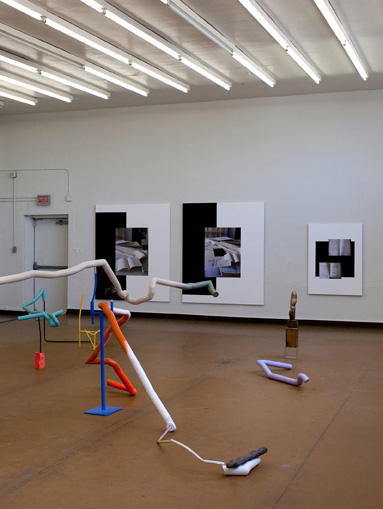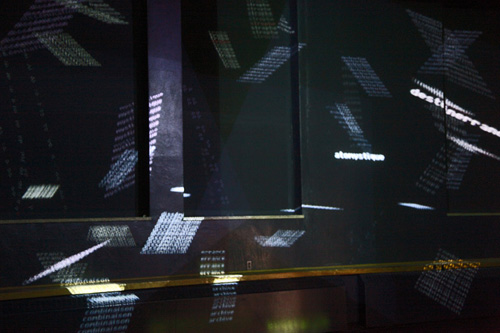Since founding the Centre International d’Art Contemporain, Claude Gosselin has been a commanding figure for Montreal’s art scene. Hosting events such as Les Cents Jours d’Art Contemporain, and more recently, The Montreal Biennale, he often acted as the middle-man between international and local artists, by putting them on equal platforms. M-KOS interviews Claude Gosselin, perhaps now at a decisive moment in his career.
M-KOS: Claude Gosselin thank you for granting us this interview, here we are already drawing near the end of this year’s Biennale and its exhibition period, can you share with us some of your impressions, are you happy with the results so far?
Claude Gosselin: Yes indeed reactions from the public and even the critics have been very good, in fact we have seen a 30% increase in visitor attendance from our previous edition, and also increases in attendance at our educational and cultural activities. We had different components of the Biennale this year, we had creative workshops, also a cinema program and an electronic arts program. Then for the satisfaction of the general audience we had a mixture of artists, half coming from Canada, half from abroad, also they were of many different generations. So there was an array of works responding to different audiences, and this is probably what caused the Biennale to be so well attended.
M: Can you tell us more about this year’s theme and choice of venue?
CG: The theme is Chance, Chance as a creative process first touched on at the beginning of the twentieth century and still very present today in the electronic arts. Chance as we read it in the poem by Stéphane Mallarmé, “Un coup de dé jamais n’abolira le hasard” (A Roll of Dice Never Will Abolish Chance), was at the heart of the visual arts taking shape with Marcel Duchamp, John Cage, Merce Cunningham and so on. Chance is a very topical theme and therefore many people have connected with it.
Another good aspect of this Biennale is that we had the opportunity to enter what was the old Fine Arts School of Montreal, a heritage building built in 1922. This is precisely where the Automatistes, Pellan and others have studied, where they rebelled against the school directors at the time, this is also where the protests of 1968-69 were held. It’s a place that contains a lot of history and many people were very happy to re-appropriate the venue for themselves, to return here and see what the School of Fine Arts was like at the time.
Ian Wallace (pictures), “Les Pages répandues” (2011), Acrylic and photolaminate on canvas, variable dimensions, Courtesy of Yvon Lambert New York, Photo Credit: the artist / David Armstrong Six (sculptures) “L’Esprit de l’escalier” (partial view), 2011, wood, steal, bronze, paint, plaster and glass, Variable dimensions, Courtesy of Parisian Laundry, Photo: Ludovic Beillard / BNL MTL 2011
M: So every time the Biennale is presented, you change its theme, as well as its venue. Is this part of the mandate of the Biennale?
CG: The Montreal Biennale is organized by the CIAC (International Centre for Contemporary Art), which is a management office. We don’t have a permanent venue for the presentation of exhibitions, for each of our activities we need to search for adequate locations. It’s not always easy but so far we have managed since 1985 to present exhibitions in venues which are not museums, we often use commercial premises like the shopping mall of Place du Park, which is now the home of La Grande Bibliothèque, we have also used large warehouses and such like. This is not an easy task now that Montreal has developed so much in recent years, unused locations are increasingly rare, especially when you think that we need a surface of around 3,000 square meters, and that we can’t afford to pay for the full rental fees. So far we have been lucky but there is an increasing scarcity for such spaces in the centre of the island of Montreal. Undoubtedly spaces are available outside the centre, but we’ll have to see how we can continue to be lucky with the Montreal Biennale. At this point would be advantageous to have a permanent venue, or at least permanent agreements with an existing venue that have the infrastructure to accommodate us, in personnel or in space.
When other biennales in the world are held either inside a museum, or a large exhibition center, here we have been a bit homeless and it hasn’t been an easy task, since each time a significant amount of investment has had to go for bringing up spaces to exhibition standards. Money that instead could have gone directly to commissioning works, has had to go into building exhibition walls, lighting and so on, for very short showing periods. In the 30 days of the Montreal Biennale, we also need to provide continued monitoring, personnel, insurance and presence at the venues. This is a project keeping us very busy, and having a permanent venue for the Montreal Biennale would definitely be a plus. Still, we are happy to have done what we did, if we were not happy, we wouldn’t have done for it 20 years, that’s how long the CIAC has been operating.
M: And you have worked with others in the process of selecting artists ?
CG: This biennial is not exclusively my curatorial project, I did it with David Liss, director of the Museum of Contemporary Canadian Art in Toronto. I invited David to join me for the 2011 Biennale, and to work with me on the theme of chance. I proposed the theme and we both agreed that it was worth pursuing, and we both provided a shortlist of artist names, then decided on the final list together. So it is a joint project with David Liss as co-curator for visual arts, Paule Mackrous who selected the five artists in the electronic arts section and Gilles Dagneau, responsible for the presentation of works by Molinari, at the Molinari Foundation.
M: Can you tell us about the artists you’ve chosen, is it true many have produced new works specifically for the Biennale ?
CG: Yes, we received several new works, starting with seniors like Jean Dupuy, with a piece setting a context between Chernobyl and Fukushima, then another one with a motorcycle, emitting gases into the atmosphere to discuss environmental concerns. Ian Wallace from Vancouver made a whole new series of works relating to the theme of Mallarmé’s poem, which is very good. We also have a new piece by David Armstrong Six, an artist from Toronto who now lives in Montreal, and Sylvie Cotton made a new arrangement of works she has shown here and there, the works previously lived independently, and for the Biennale she put them together to form a complete environment. Then German artist John Bock produced a major construction work, inside which he actually spent a week shooting a new film, which will be exhibited at the Basel Art Fair in June, along with an installation derived from what he has done in Montreal. This film will also be launched in theatres next autumn. Many artists like that came with new works. I think an important aspect of the Biennale is to present new works, which are made either on site or are very recent or very closely relate to the theme of the Biennale.
Jean Dubois “Brainstorm†(2011) Interactive In Situ video installation, Photo: the artist
M: Does the theme of Chance also apply to the electronic arts section ?
CG: Yes, because new technologies often allow the public to participate. If you look at the iPhone, blogs, Flickr and all the new software made available to artists working directly on computers, there are always features allowing audiences to enter the artwork, to update it, and give it a new direction. All this allows the artwork, which is no longer fixed in painting on a canvas, but dynamic through new technologies, to stay in movement, or in development, in progress. This is very important today. Young people are very fond of being involved in the transformation of the work.
M: Surely you will agree, like good wine, maybe the Biennale had good years and others not so good, is there an edition that you’re particularly fond of ?
CG: Much has been said about the previous Biennial of 2009, how it more or less responded to expectations. In reality, we need to point out that this biennial focused on new technologies, and art critics in Montreal have very little experience in new technologies. They expected more traditional works. So because the art critics didn’t find a lot of traditional works, they weren’t at ease to speak of new technologies, therefore according to them it wasn’t a good Biennale. I have had good reviews in 2009 outside, but not within Montreal. What can you do, if you had to rely on art critics to decide on whether to continue a biennale, the Whitney Biennial would be gone, so would Venice. Things are happening at another level.
Personally I’ve always been happy about the Biennales we made in the past, although sometimes the space we chose was a bit difficult. But the Biennale of 2009 was nevertheless a success according to our young audience, as we had to extend the exhibition time for one-week, to accommodate all the school activities. This tells us how much technologies correspond to new ways of looking by young people, and that there is a kind of opposition between the static side of works found in the museum and the dynamic dimension of works made from computers.
M: Is controversy still a big part of the art press in Montreal and elsewhere ?
CG: Yes, but what I regret is when we invite our critics to come and meet the artists. When we do a Biennial with half of the artists Canadians, and the other half non-Canadians, and critics are never able to write one line about non-Canadians. According to them, the only good artists are the Canadian ones, and they don’t go and interview the others when they are on site. It’s been 30 years since I do these activities with all these artists who come from elsewhere, and not an art critic has done an interview with an international artist of great reputation.
This year, only LaPresse interviewed Jean Dupuy, as well as Ian Wallace. These were the only direct interviews we had with our artists. I see no reason why other, more serious newspapers didn’t interview Jean Dupuy, who is now 85 years old, and one of the last living Fluxus artists. He has an incredible history behind him, and nobody even mentioned it. The same can be said about Daniel Spoerri, when it’s his first time showing in Montreal.
M: And what does the future hold for you, new projects, more Biennials ?
CG: For now I’ll be taking a rest when the Biennale finishes, then I’ll commit to new projects, locally or internationally, I don’t know which yet but there are things on the horizon, so we’ll see. Let’s just say I’ve given enough within this event, and other people are doing the Triennial at the Montreal Museum of Contemporary Art, now the National Gallery of Canada are trying to do a biennale in Ottawa, and Toronto wants one as well. As far as I’m concerned this is my last Biennale at the CIAC. Plans for Montreal Biennales in 2013, 2015 and 2017 are already in motion, but it will not be me at the head.
We will have a publication coming out in September also on the theme of chance, which is coordinated by an artist and a designer in New York. It will be published by Farimani, an international publisher, and includes international collaborators. But unfortunately with the Biennale we’re not counting too much on Montreal to raise it to an international level, or to recognize the quality of what is presented. We are never prophets in our own land.
–– Interviewd by Oli Sorenson (originally in French)
The 7th edition of The Montreal Biennale is held from May 1st to 31st, 2011, bring together works of artists from QueÌbec, Canada and abroad. Its three main venues are
The former École des beaux-arts at Montréal
Open daily from noon to 6 pm, Thursday extended until 9 pm.
3450, St. Urbain Street at the corner of Sherbrooke Street West.
Place des Arts. Bus : 80 or 129.
La Fondation Guido Molinari
Open Wednesday to Sunday, from noon to 5 pm, last entrance at 4:30 pm.
3290, Sainte Catherine East Street.
Papineau, Frontenac, Préfontaine. Bus: 34, 29 or 125.
Le Cinéma du Parc
Open every Sunday from May 2011.
3575, Avenue du Parc
Place des Arts. Bus : 80 or 129.




One Reply to “Interview: Montreal Biennale Artistic Director Claude Gosselin”